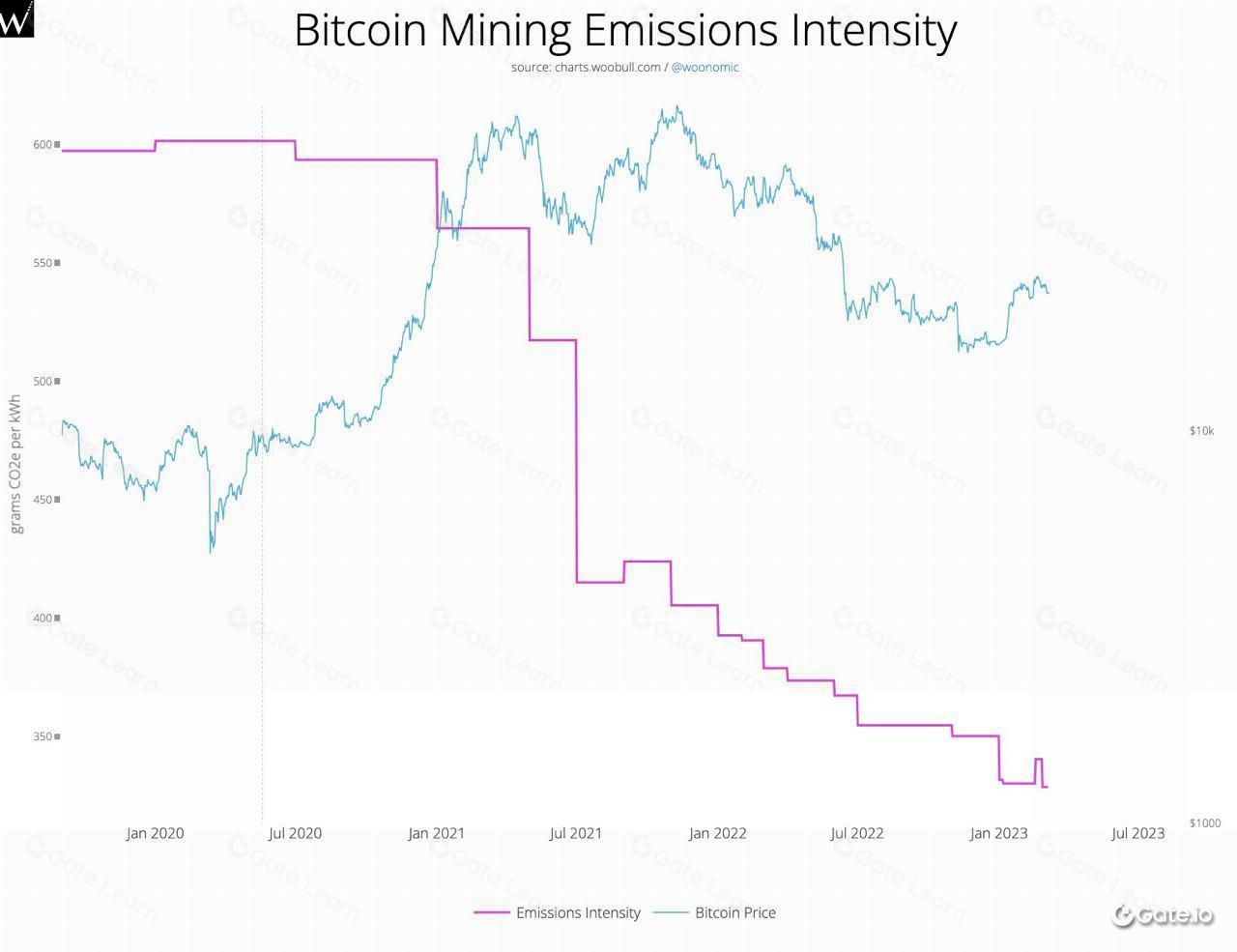Tác động môi trường của việc khai thác tiền điện tử
Những lo ngại về tác động môi trường của tiền điện tử đã tăng lên khi nó ngày càng phổ biến và có giá trị. Khai thác bitcoin tiêu thụ một lượng năng lượng đáng kể và kỹ thuật này đã bị trừng phạt vì tác động môi trường của nó. Trong bài học này, chúng ta sẽ xem xét tác động môi trường của việc khai thác bitcoin và thảo luận các cách để giảm thiểu nó.
Tổng quan về tác động môi trường của việc khai thác Bitcoin
Khai thác tiền điện tử sử dụng rất nhiều năng lượng, điều này có tác động lớn đến môi trường. Lượng năng lượng cần thiết để khai thác tiền điện tử như Bitcoin và Litecoin là rất lớn. Theo phân tích của Đại học Cambridge, mức sử dụng năng lượng hàng năm của mạng Bitcoin tương tự như mức sử dụng năng lượng của toàn bộ các quốc gia như Argentina hoặc Hà Lan. (Chúng ta sẽ xem xét ít về điều này, tiếp tục theo dõi bài học).
Bởi vì khai thác bitcoin tiêu thụ rất nhiều năng lượng, nên nó để lại lượng khí thải carbon lớn, góp phần vào sự nóng lên toàn cầu và biến đổi khí hậu. Điện năng tiêu thụ để chạy các thiết bị khai thác và hệ thống làm mát góp phần tạo ra lượng khí thải carbon trong hoạt động khai thác tiền điện tử. Các hoạt động khai thác đòi hỏi hệ thống điều hòa không khí và làm mát tiêu thụ nhiều năng lượng hơn.
Việc sản xuất và xử lý phần cứng khai thác là một thành phần khác góp phần vào tác động môi trường của việc khai thác tiền điện tử. Các nhà sản xuất phần cứng khai thác sử dụng nguồn tài nguyên và năng lượng khổng lồ, và việc xử lý phần cứng khai thác có thể gây ô nhiễm môi trường.
Hiểu mức tiêu thụ năng lượng của khai thác
Để hiểu được tác động môi trường của việc khai thác tiền điện tử, trước tiên người ta phải hiểu được việc sử dụng năng lượng của quy trình. Một số yếu tố ảnh hưởng đến việc sử dụng năng lượng khai thác, bao gồm loại phần cứng được sử dụng, thuật toán khai thác và chi phí điện.
ASIC là thiết bị khai thác sử dụng nhiều năng lượng nhất (Mạch tích hợp dành riêng cho ứng dụng). ASIC được thiết kế dành riêng cho khai thác bitcoin và mang lại hiệu quả và hiệu suất tuyệt vời. Tuy nhiên, mức tiêu thụ năng lượng đáng kể của họ góp phần rất lớn vào tác động môi trường của khai thác mỏ. (Trong những năm gần đây, ASIC đang được phát triển nhằm cố gắng giảm mức tiêu thụ năng lượng)
Một khía cạnh quan trọng khác trong việc sử dụng năng lượng khai thác là chi phí điện năng. Khai thác đòi hỏi nhiều năng lượng hơn ở những khu vực có chi phí điện cao. Công cụ khai thác ở các địa điểm có chi phí điện thấp có lợi thế lớn về lợi nhuận, nhưng lượng năng lượng lớn cần thiết để khai thác tiền điện tử vẫn có thể gây ra tác động môi trường đáng kể.
Chiến lược giảm thiểu tác động môi trường khai thác mỏ
Nhiều biện pháp có thể được sử dụng để giảm bớt tác động môi trường của việc khai thác tiền điện tử.
Nguồn năng lượng tái tạo
Sử dụng các nguồn năng lượng tái tạo là một trong những chiến lược hiệu quả nhất để giảm bớt tác động môi trường của việc khai thác mỏ. Các nguồn năng lượng tái tạo như năng lượng mặt trời, gió và thủy điện có thể cung cấp nguồn năng lượng lâu dài cho các hoạt động khai thác. Nhiều trang trại khai thác trên khắp thế giới đã chuyển sang năng lượng tái tạo để cung cấp năng lượng cho hoạt động của họ.
Phần cứng tiết kiệm năng lượng
Việc sử dụng phần cứng khai thác tiết kiệm năng lượng như GPU (Bộ xử lý đồ họa) thay vì ASIC cũng có thể giúp giảm bớt tác động môi trường của hoạt động khai thác. GPU tiêu thụ ít năng lượng hơn và là giải pháp thay thế thân thiện với môi trường hơn so với ASIC.
Tối ưu hóa khai thác
Tác động môi trường của khai thác có thể được giảm thiểu bằng cách tối ưu hóa quy trình khai thác. Điều này có thể thực hiện được bằng cách tối ưu hóa cài đặt phần cứng và phần mềm khai thác, tăng cường hệ thống làm mát và giảm thời gian chết. Các nhóm khai thác cũng có thể được sử dụng để cải thiện quy trình khai thác bằng cách giảm lượng năng lượng cần thiết để khai thác một mình.
Tái sử dụng và tái chế phần cứng
Tái chế và tái sử dụng phần cứng khai thác cũng có thể giúp giảm bớt tác động môi trường của việc khai thác. Các thành phần của phần cứng khai thác cũ có thể được tái sử dụng cho mục đích sử dụng khác, giảm thiểu nhu cầu phát triển phần cứng mới.
Những cải tiến về tính bền vững
Dữ liệu Báo cáo & Phân tích của Cambridge
Một nghiên cứu khá gần đây của Trung tâm Tài chính Thay thế Cambridge cho thấy rằng tỷ lệ các nguồn năng lượng tái tạo được sử dụng bởi các công ty khai thác bitcoin đã giảm. Nghiên cứu cho thấy rằng trong quý 2 năm 2021, khoảng 39% hoạt động khai thác bitcoin được cung cấp bởi năng lượng tái tạo, so với 74,1% trong quý 4 năm 2020. Nghiên cứu cho thấy rằng việc sử dụng năng lượng tái tạo giảm là do một số yếu tố, bao gồm cả việc di chuyển các hoạt động khai thác từ Trung Quốc sang các khu vực khác, nơi hỗn hợp năng lượng có thể ít tái tạo hơn.
Báo cáo cũng lưu ý rằng trong khi một số cơ sở khai thác hiện đang được cung cấp bởi các nguồn năng lượng tái tạo, nhiều hoạt động khai thác vẫn phụ thuộc nhiều vào các nguồn không thể tái tạo như than đá. Do đó, lượng khí thải carbon của các hoạt động khai thác mỏ là một mối quan tâm, vì nó góp phần gây ra biến đổi khí hậu và hủy hoại môi trường.
Để chống lại vấn đề này, đã có những nỗ lực để phát triển các hoạt động khai thác bền vững hơn. Một số hoạt động khai thác đã bắt đầu sử dụng năng lượng tái tạo dư thừa từ các trang trại gió hoặc mặt trời, nếu không sẽ bị lãng phí, để cung cấp năng lượng cho các hoạt động khai thác của họ. Ngoài ra, một số cơ sở khai thác đang được xây dựng ở những địa điểm có nguồn năng lượng tái tạo dồi dào, chẳng hạn như Iceland, nơi có tỷ lệ nguồn năng lượng tái tạo cao.
Biểu đồ từ @woonomic hiển thị Cường độ phát thải khai thác Bitcoin:

Và tính bền vững như sau:

Daniel Batten trên Twitter đã phân tích biểu đồ sau về Tổng lượng phát thải CO2 “Lượng phát thải của mạng đang có xu hướng giảm xuống, ngay cả khi tỷ lệ băm và mức tiêu thụ điện tăng lên. Các công ty khai thác chuyển sang sử dụng năng lượng bền vững là một động lực lớn cho điều này”.

Thêm dữ liệu từ báo cáo Cambridge:
- Trung tâm Tài chính Thay thế Cambridge ước tính rằng kể từ tháng 9 năm 2022, 39% hoạt động khai thác bitcoin được cung cấp bởi năng lượng tái tạo, giảm từ 47% trong quý 2 năm 2022.
- Trung Quốc vẫn là quốc gia khai thác bitcoin lớn nhất, chiếm khoảng 54% hoạt động khai thác toàn cầu. Tuy nhiên, tỷ lệ năng lượng tái tạo của đất nước trong hỗn hợp khai thác đã giảm từ 60% trong quý 2 năm 2022 xuống còn 47% trong quý 3 năm 2022.
- Kazakhstan, nơi đang nổi lên như một trung tâm khai thác tiền điện tử mới, có tỷ lệ năng lượng tái tạo cao nhất trong hỗn hợp khai thác ở mức 84%.
- Hoa Kỳ chiếm 11% hoạt động khai thác bitcoin toàn cầu và có tỷ lệ năng lượng tái tạo cao thứ hai trong hỗn hợp khai thác ở mức 35%.
- Than vẫn là nguồn năng lượng được sử dụng phổ biến nhất để khai thác bitcoin, chiếm 38% hỗn hợp khai thác toàn cầu.
- Khí đốt tự nhiên chiếm 23% hỗn hợp khai thác toàn cầu, tiếp theo là thủy điện ở mức 19% và các nguồn năng lượng tái tạo như năng lượng mặt trời và gió ở mức 15%.
Dữ liệu cung cấp một số thông tin chi tiết về hiện trạng tiêu thụ năng lượng và tính bền vững trong lĩnh vực khai thác mỏ.
Rất nhiều người tranh luận về tính bền vững của Bitcoin, so sánh lượng khí thải carbon của nó với các nguồn phát thải carbon khác. Thực tế của sự so sánh này là trong đồ họa sau:

Báo cáo của Hội đồng khai thác Bitcoin (BMC)

Theo một nghiên cứu của tổ chức nghiên cứu Đại học Cambridge, hỗn hợp năng lượng bền vững được sử dụng để khai thác Bitcoin có thể đang giảm. Tuy nhiên, kết quả nghiên cứu đã bị thách thức bởi một báo cáo gần đây từ Hội đồng khai thác Bitcoin (BMC). BMC tuyên bố rằng việc khai thác Bitcoin tận dụng 52,6% năng lượng bền vững, khiến nó trở thành một khoản đầu tư ESG (Môi trường, Xã hội và Quản trị) thuận lợi.
Mô hình CCAF được BMC sử dụng loại trừ một số yếu tố có thể ảnh hưởng đến tính toán hỗn hợp năng lượng bền vững. Ví dụ: mô hình không tính đến khai thác ngoài lưới, khai thác bằng khí đốt và tỷ lệ băm địa lý cập nhật, điều này có thể dẫn đến đánh giá thấp việc sử dụng năng lượng bền vững. Mặt khác, một số yếu tố như việc sử dụng thiết bị làm mát và đo lường tỷ lệ băm không chính xác có thể làm giảm con số sử dụng năng lượng bền vững.
Theo báo cáo của BMC, với tất cả các loại trừ được tính đến, tính toán hỗn hợp năng lượng bền vững là 52,6%. Ước tính này là ước tính giới hạn dưới, nghĩa là con số thực có thể cao hơn. Con số này không mâu thuẫn với nghiên cứu của Đại học Cambridge, cho thấy hỗn hợp năng lượng bền vững là 58,9%.
Để có hỗn hợp năng lượng bền vững dưới 50%, một trong các tình huống sau sẽ phải đúng: bốn hoạt động khai thác Bitcoin lớn bí mật sử dụng 100% năng lượng từ than đá, ERCOT đã báo cáo quá mức về số lượng năng lượng tái tạo thực sự của mình bởi một hệ số bốn, hoặc cuộc di cư của những người khai thác khỏi Kazakhstan đã không làm giảm tỷ lệ băm toàn cầu. Tuy nhiên, những kịch bản này khó xảy ra và tỷ lệ phần trăm bền vững thực sự của mạng Bitcoin khó có thể là 37,6%.
Tóm lại, một số hoạt động khai thác đã bắt đầu sử dụng năng lượng tái tạo dư thừa từ các trang trại gió hoặc mặt trời để cung cấp năng lượng cho hoạt động khai thác của họ và một số cơ sở khai thác đang được xây dựng ở những nơi có nguồn năng lượng tái tạo dồi dào. Báo cáo của BMC thách thức nghiên cứu của Đại học Cambridge, cho thấy rằng hỗn hợp năng lượng bền vững được sử dụng bởi hoạt động khai thác Bitcoin có thể cao hơn so với ước tính trước đây và ngành khai thác Bitcoin hướng đến mục tiêu không có carbon trong tương lai gần. Nhìn chung, rõ ràng là hoạt động vì tính bền vững rất cao và ngành đang thực hiện các bước để giảm lượng khí thải carbon và tăng tỷ lệ các nguồn năng lượng tái tạo được sử dụng trong các hoạt động khai thác.
Tóm tắt các khái niệm chính được đề cập trong khóa học
Trong suốt khóa học này, chúng tôi đã nghiên cứu các ý tưởng cơ bản về khai thác tiền điện tử, chẳng hạn như cách hoạt động của hoạt động khai thác, nhiều loại phần cứng khai thác và tác động môi trường của việc khai thác. Chúng tôi cũng đã nói về sự cần thiết của việc lựa chọn phần mềm và công cụ khai thác phù hợp, cũng như các phương pháp hay nhất để quản lý và bảo vệ các hoạt động khai thác.
Một kết luận quan trọng là, trong khi khai thác có thể là một ngành kinh doanh có lợi nhuận, thì đây cũng là một ngành khó khăn và luôn thay đổi, đòi hỏi phải thích ứng liên tục. Để thành công trong việc khai thác tiền điện tử, điều quan trọng là phải theo kịp những tiến bộ và xu hướng mới nhất trong khu vực.
Một yếu tố quan trọng khác cần xem xét là tác động môi trường của việc khai thác mỏ, đây là mối quan tâm chính của nhiều người trong doanh nghiệp. Mặc dù các nỗ lực đang được thực hiện để thiết lập các quy trình khai thác bền vững hơn, nhưng điều quan trọng đối với các công ty khai thác là đánh giá tác động môi trường của họ và thực hiện các hành động để giảm lượng khí thải carbon của họ.
Mẹo thiết thực để bắt đầu khai thác tiền điện tử
Dưới đây là một số gợi ý hữu ích cho những cá nhân muốn bắt đầu khai thác bitcoin:
Trước khi đầu tư vào phần cứng khai thác, hãy kiểm tra các khả năng khác nhau có sẵn và chọn một thiết bị phù hợp với loại tiền điện tử bạn muốn khai thác.
Chọn phần mềm khai thác phù hợp: Chọn phần mềm khai thác tương thích với phần cứng của bạn và có chức năng bạn yêu cầu để nâng cao hiệu suất khai thác.
Tham gia nhóm khai thác: Bằng cách chia sẻ tài nguyên của bạn với những người khai thác khác, bạn có thể cải thiện cơ hội giành được phần thưởng khai thác.
Xem xét tác động môi trường: Để giảm lượng khí thải carbon của bạn, hãy xem xét áp dụng các nguồn năng lượng tái tạo để cung cấp năng lượng cho hoạt động khai thác của bạn và khám phá các kỹ thuật khai thác bền vững khác.
Theo kịp những tiến bộ của ngành: Khi thị trường khai thác tiền điện tử phát triển, hãy theo kịp những cải tiến và xu hướng mới nhất để điều chỉnh kế hoạch khai thác của bạn một cách hợp lý.
Tóm lại, khai thác tiền điện tử có thể là một nỗ lực mang lại lợi nhuận, nhưng nó đòi hỏi phải xem xét cẩn thận các tiêu chuẩn về phần cứng, phần mềm và tính bền vững. Những người khai thác có thể phát triển thịnh vượng trong ngành năng động và hấp dẫn này bằng cách cập nhật thông tin liên tục và áp dụng những nỗ lực thiết thực để tối đa hóa hiệu suất khai thác và hạn chế tác động đến môi trường. Cảm ơn vì đã tham gia khóa học này!





